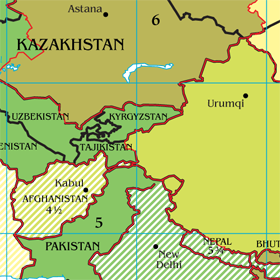We all know that parallel lines never meet, and it’s convenient to think of the lines of longitude and timezones as parallel, but they really aren’t. The former because they’re inscribed on the (more or less) spherical Earth, and the latter because they’re entirely made up, a construct of how we measure time. This trippy insight, acquired whilst contemplating the stunning entirely of Bruce Myren’s 40th Parallel project at Gallery Kayafas, led me to some interesting trivia about time zones.
Also, I was trying to sort out lead assignment for various shifts of telesales reps, but that’s a lot less interesting.
Leaving aside the puzzlement that is the International Date Line, it turns out there are places where you can travel more than one timezone at once, and relatedly, places where three timezones converge at a single point.
Take for example the convergence of Norway, Finland, and Russia. At that point you can hop from UTC +1 in Norway, UTC +2 in Finland, and UTC +3 in Russia, if the border guards let you. There are some similar spots in the middle of Russia, if you want to do the Time Warp without crossing international boundaries. The CIA has an awesome timezone map available in PDF, from which these are clipped:
China has just one time zone from end to end, even though in neighboring counties, that span covers several time zones. So when leaving China to the West, you can go jump back two hours to Kazakstan, three to Kyrgyz-, Tajiki- and/or Pakistan, or even three and a half hours, to Afghanistan via the treacherous Wakhjir Pass. The web of timezones that are more or less than a whole hour from their neighbors make South and Central Asia even more confusing.
I thought that 3.5 hours was the biggest jump possible, and wikipedia says it is in the above linked article, but I think it’s more complicated that that. Around the South pole, in Antarctica, in theory all time zones would converge on that point, but that would be very tricky on a practical level.
It turns out that various parts of Antarctica observe a range of time zones from UTC -6 through UTC +12, and the borders of these zones could cause some even bigger jumps in time for people there, if they were ever to traverse those frozen boundaries.
I got a headache (and maybe brain freeze) looking at this, but I think you can gain or lose at least ten hours going in and out of the inland zone, which is oddly labeled “Vostok” which I’m pretty sure means “East” in Russian (Восток). Which way is East at the South pole?? Without even opening the can of worms that is Daylight Saving Time, let’s just say you’re going to need more watches than you wore back in the 80s.
Not confused enough? Check out the largest island in a lake on an island in a lake on an island. If you’re already there, please send me a postcard!




We spent NYE at Surveyor Generals Corner in Australia where 3 time zones converge. We spent 2.5 hrs celebrating 3 new year eves. We wondered if this circumstance occurs elsewhere. Your web site shows it does, but also we worked out that it ocurrs at two more places in Australia, Poepels Corner and Camerans Corner. This is made possible by daylight savings in only some of Australia’s states.
Happy New Year
Tim